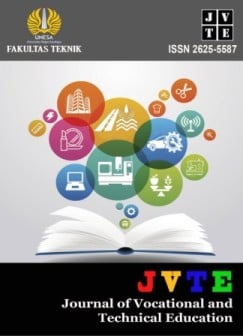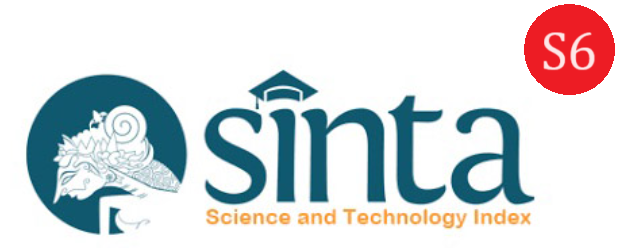PENERAPAN METODE NHT UNTUK MENINGKATKAN PRESTASI BELAJAR SISWA PADA MAPEL DTSM KELAS X TSM 1 DI SMKN 11 MALANG
DOI:
https://doi.org/10.26740/jvte.v7n2.p37-44Keywords:
Numbered Head Together, Prestasi Belajar, Elektronika Otomotif, Pembelajaran KooperatifAbstract
Penelitian ini bertujuan untuk meningkatkan prestasi belajar siswa kelas X TSM 1 SMKN 11 Malang melalui penerapan model pembelajaran kooperatif Numbered Head Together (NHT) pada mata pelajaran Dasar-Dasar Teknik Sepeda Motor, khususnya pada materi elemen dasar elektronika otomotif. Metode penelitian yang digunakan adalah Penelitian Tindakan Kelas (PTK) dengan model spiral Kemmis dan McTaggart yang terdiri dari dua siklus. Setiap siklus meliputi tahap perencanaan, tindakan, observasi, dan refleksi. Subjek penelitian adalah 36 siswa kelas X TSM 1. Data dikumpulkan melalui tes hasil belajar, observasi, dan dokumentasi. Hasil penelitian menunjukkan adanya peningkatan ketuntasan belajar dari 51,61% pada tahap prasiklus menjadi 74,19% pada siklus I dan meningkat lagi menjadi 93,55% pada siklus II. Rata-rata nilai siswa juga meningkat dari 69,32 menjadi 81,87. Selain itu, pembelajaran dengan NHT mampu meningkatkan partisipasi aktif siswa, motivasi belajar, dan pemahaman konsep secara mendalam. Model NHT juga memfasilitasi pengembangan soft skills seperti kerja sama, komunikasi, dan tanggung jawab. Suasana kelas menjadi lebih dinamis dan kolaboratif, dengan siswa aktif berdiskusi, bertanya, dan menjelaskan konsep kepada teman sekelompoknya. Temuan ini menegaskan bahwa model NHT efektif dalam meningkatkan kualitas pembelajaran teknik di SMK, baik dari aspek kognitif maupun afektif. Oleh karena itu, penerapan model ini direkomendasikan untuk digunakan secara luas dalam pembelajaran kejuruan berbasis keterampilan.
This study aims to improve the academic achievement of 10th-grade students in the Motorcycle Engineering and Business program at SMKN 11 Malang through the implementation of the cooperative learning model Numbered Head Together (NHT) in the Basic Motorcycle Engineering subject, specifically in basic automotive electronics. The research employed a Classroom Action Research (CAR) method using the Kemmis and McTaggart spiral model consisting of two cycles. Each cycle included planning, action, observation, and reflection stages. The research subjects were 36 students of class X TSM 1. Data collection was carried out through achievement tests, observations, and documentation. The results showed a significant increase in learning mastery from 51.61% in the pre-cycle to 74.19% in cycle I and then to 93.55% in cycle II. The average score also rose from 69.32 to 81.87. Moreover, NHT effectively enhanced students’ active participation, learning motivation, and conceptual understanding. It also promoted the development of soft skills such as collaboration, communication, and responsibility. The classroom environment became more dynamic and collaborative, with students engaging in discussions, asking questions, and explaining concepts to their peers. These findings confirm that the NHT model is effective in improving the quality of vocational learning in technical education, both cognitively and affectively. Therefore, this model is recommended for broader application in skill-based vocational education.
References
[1] World Economic Forum, “The Future of Jobs Report 2023,” Geneva: World Economic Forum, 2023. https://www.weforum.org/publications/the-future-of-jobs-report-2023/.
[2] R. Arends, Learning to Teach, 9th ed. New York: McGraw-Hill Education, 2012.
[3] N. Sudjana, Dasar-Dasar Proses Belajar Mengajar. Bandung: Sinar Baru Algensindo, 2021.
[4] D. Pradipto, “Peningkatan Keaktifan Belajar Siswa pada Kompetensi Dasar Menggunakan Elemen Pasif Dalam Rangkaian Listrik Arus Searah melalui Penerapan Model Pembelajaran Post Solution Posing Siswa Kelas X Program Keahlian Teknik Instalasi Tenaga Listrik SMK Negeri 3 Yo,” UNIVERSITAS NEGERI YOGYAKARTA, 2017.
[5] R. E. Slavin, N. Yusron, and Zubaedi, Cooperative Learning: Teori, Riset, dan Praktik. Bandung: Nusamedia, 2015.
[6] I. P. Sari and M. Hidayat, “Pengaruh Model Pembelajaran Kooperatif Tipe Numbered Head Together terhadap Hasil Belajar Teknik Otomotif,” J. Pendidik. Tek. Mesin, 2021, doi: https://doi.org/10.26877/jptm.v9i2.8964.
[7] A. N. Puthree, D. W. Rahayu, M. Ibrahim, and ..., “Analisis faktor penyebab rendahnya motivasi belajar siswa sekolah dasar selama pembelajaran daring,” J. …, 2021, [Online]. Available: http://repository.unusa.ac.id/id/eprint/10592.
[8] A. Wijayanto, Suparman, and I. Maryani, “Strategi Pembelajaran Kolaboratif dalam Pembelajaran Praktik di SMK,” J. Inov. Pendidik. Tek. Mesin, 2020, doi: https://doi.org/10.21831/jiptm.v6i1.35642.
[9] D. W. Johnson and R. T. Johnson, Cooperation and Competition: Theory and Research. Interaction Book Company, 2018.
[10] Kemendikbudristek, “Kebijakan Merdeka Belajar untuk Pendidikan Vokasi,” 2022.
[11] A. Susanto, Teori Belajar & Pembelajaran di Sekolah. Jakarta: Kencana, 2020.
[12] M. Rohman and D. Sugiarto, “Integrasi Media Digital dalam Pembelajaran Kolaboratif di SMK,” J. Pendidik. Teknol. dan Kejuru., 2021.
[13] J. Biggs and C. Tang, Teaching for Quality Learning at University. New York: McGraw-Hill, 2011.
[14] S. Kemmis and R. McTaggart, PARTICIPATORY ACTION RESEARCH Communicative Action and the Public Sphere, vol. 14, no. 4. 2014.
[15] Sugiyono, Metode Penelitian Pendidikan: Pendekatan Kuantitatif, Kualitatif, dan R&D. Bandung: Alfabeta, 2019.
[16] L. J. Moelong, Metodologi Penelitian Kualitatif (Edisi Revisi). Bandung: PT Remaja Rosdakarya, 2018.
[17] J. W. Creswell and J. D. Creswell, Research Design: Qualitative, Quantitative, and Mixed Methods Approaches, 5th ed. Thousand Oaks: CA: SAGE Publications, 2018.
[18] A. R. Subiyantari and S. Muslim, “PENGARUH MODEL PEMBELAJARAN KOOPERATIF TIPE JIGSAW TERHADAP HASIL BELAJAR SISWA SMK,” JVTO J. Vokasi Tek. Otomotif, 2019.
Downloads
Published
How to Cite
Issue
Section
License

This work is licensed under a Creative Commons Attribution-NonCommercial-ShareAlike 4.0 International License.
 Abstract views: 48
,
Abstract views: 48
, PDF Downloads: 29
PDF Downloads: 29






